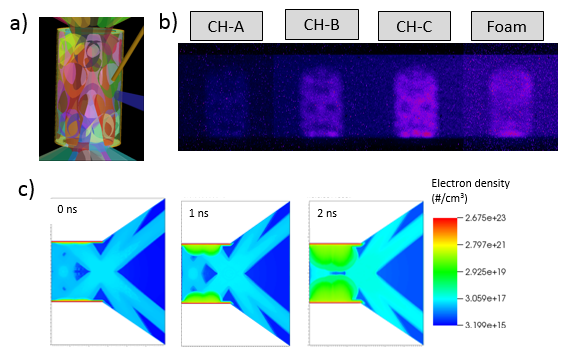Patrick Poole (17-ERD-109)
Executive Summary
Our goal is to develop an x-ray light source that will yield an improved rate of conversion of the energy produced by high-energy lasers or pulsed power devices, exceeding current x-ray intensities by an order of magnitude. This research will also enable extreme-environment material testing for national security and related applications.
Project Description
The development of an x-ray light source is an active area of research at Lawrence Livermore’s National Ignition Facility (NIF) that will reveal fundamental physics of x-ray interaction with matter as well as enabling extreme-environment material testing for national security and related applications. We are developing an enhanced bremsstrahlung source that aims to fill a critical gap in the spectral range for which high-fluence x-rays can be produced by high-energy lasers or pulsed power devices. Currently, x-ray source development targets at the NIF can produce large amounts (~10 kJ) of x-rays near 20 keV from characteristic emission of molybdenum and silver, but these sources and conventional hohlraum shots have poor conversion efficiency (< 0.1%) for 50-keV x-rays. Pulsed power sources can produce hard x-rays with energy in excess of several hundred kiloelectronvolts, but lose conversion efficiency precipitously in the few-hundred-kiloelectronvolt range, and even these energies cannot be generated without much higher fluences of harder x-rays that then dominate target interactions. We intend to achieve high fluences of high-energy x-rays by optimizing laser energy conversion into plasma instabilities and bremsstrahlung radiation. Our goal is to develop laser–plasma instability control to enhance energy conversion into accelerated electrons and thereby exceed current x-ray intensities by an order of magnitude. An understanding of high-energy, laser–plasma instability control will be developed with modeling and scaled condition shots on the high-power lasers at the NIF and the Omega laser facility at the Laboratory for Laser Energetics in Rochester, New York.
The development of an x-ray source supports space and military applications related to national defense by providing extreme radiation environment conditions in which to test properties such as material radiation hardness. Because the applications often require high-fluence-area product exposure in specific x-ray energy bands, the ability to tailor the experimentally generated spectrum is critical. We expect to increase laser energy conversion into plasma-wave-accelerated electrons, with an ultimate theoretical goal of 40%. Even a modest success of 15% will constitute an order of magnitude enhancement over current x-ray fluences. The expected goal is to surpass current NIF x-ray fluence in the 30- to 100-keV range by an order of magnitude by optimizing instabilities such as stimulated Raman scattering and two-plasmon decay through laser, plasma, and target parameters. Strategies obtained from previous instability reduction efforts include beam-wavelength tuning and bremsstrahlung converter material and thickness adjustment, as well as fundamental studies of plasma density and temperature scaling. The resulting x-ray spectrum will enable national security tests in extreme x-ray environments to continue into regimes that were previously inaccessible, and will additionally develop a platform for fundamental scientific studies related to plasma waves and x-ray interactions with matter. The resulting plasma instability control will not only aid future laser fusion ignition efforts that seek their suppression, but also will enable a critically inaccessible regime of bremsstrahlung x-ray production to be realized. In addition, the x-ray data obtained on high-power laser test platforms will be of interest to large portions of the high-energy-density physics community.
Mission Relevance
By developing an x-ray source that can achieve high flux in the 30- to 100-keV energy range, this research supports the Laboratory’s core competency in high-energy-density science. Additionally, the accompanying plasma instability control will be of use to fusion research (by reducing conversion to electrons), as well as fundamental science projects (e.g., astrophysically relevant plasma-wave effects) on the NIF laser.
FY17 Accomplishments and Results
In FY17, we (1) planned a shot day on Omega aimed at enhancing the x-ray yield in the 30+ keV range by varying laser and target parameters; (2) prepared for shot day by performing particle-in-cell (or PIC, a method by which similar particles are grouped together into macroparticles and their interactions followed using discrete time steps) and hydrodynamic modeling to ascertain the optimum plasma conditions (temperature, density) for instability growth and to obtain estimates for x-ray yield; (3) used the PIC, hydrodynamic models, and existing techniques to create two initial target designs to be tested on Omega; and (4) finalized diagnostic setup and procured targets.
Publications and Presentations
Poole, P. et al. 2017. "Toward High Fluence, High Energy X-ray Sources via Control and Optimization of Plasma Instabilities." 47th Annual Anomalous Absorption Conference, Florence, OR, 11–16 June 2017. LLNL-ABS-730538.
——— 2017. "Plasma Instability Control Toward High Fluence, High Energy X-ray Continuum Source." 59th Annual Meeting of the APS Division of Plasma Physics, Milwaukee, WI, 23–27 October 2017. LLNL-ABS-734844.
   





